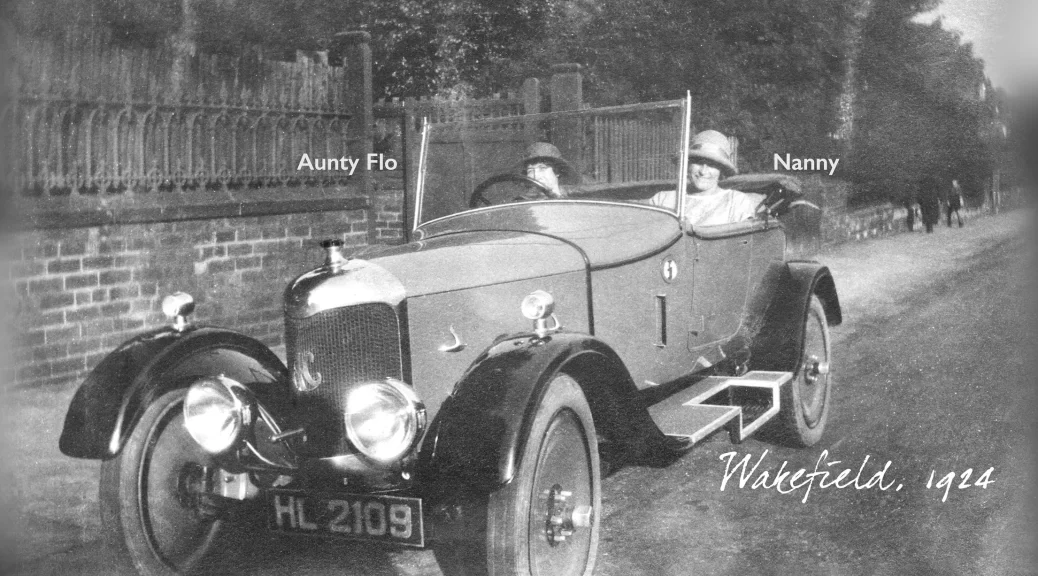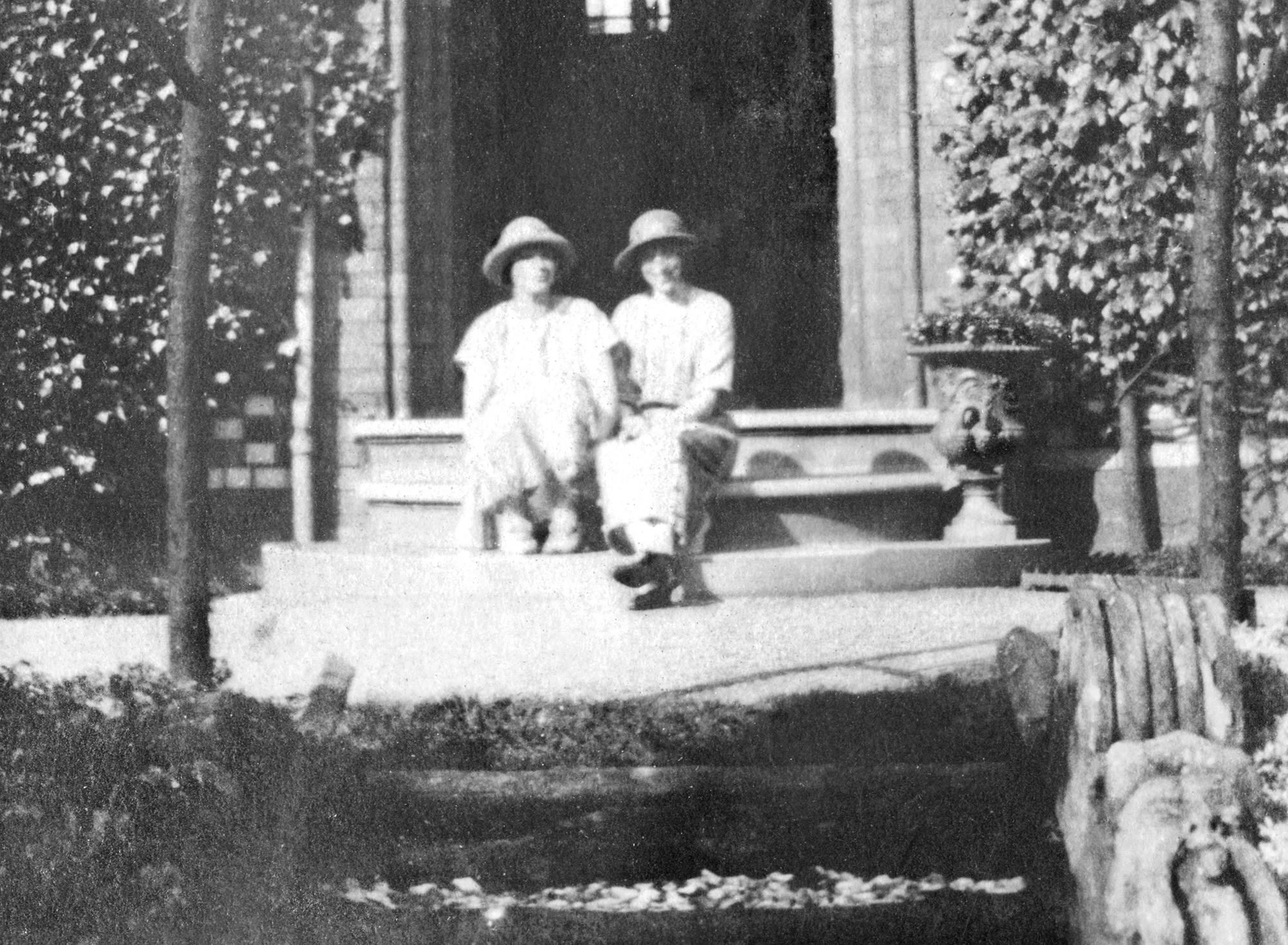
Tales of the extended Shepherd family and two Shepherd sisters, my great grandmother Mary Ann and Emily are in earlier blog posts – I didn’t realize I hadn’t finished! I recently scanned a photograph from my grandmother’s album captioned Aunty Flo, Wakefield 1924 and realized I didn’t know who Flo was. The photo doesn’t have much detail, but the two women looked roughly the same age – my grandmother was 27. A short wander through the family tree convinced me it was Florence Shepherd, my great grandmother’s youngest sister (a young-looking 42).

After piecing many records and pictures together to tell her story, I realized that after the Summer of 1917, Florence was the last maternal relative standing for my Grandfather and his 5 surviving sisters. She played a particularly important role for the two youngest girls – as their guardian.
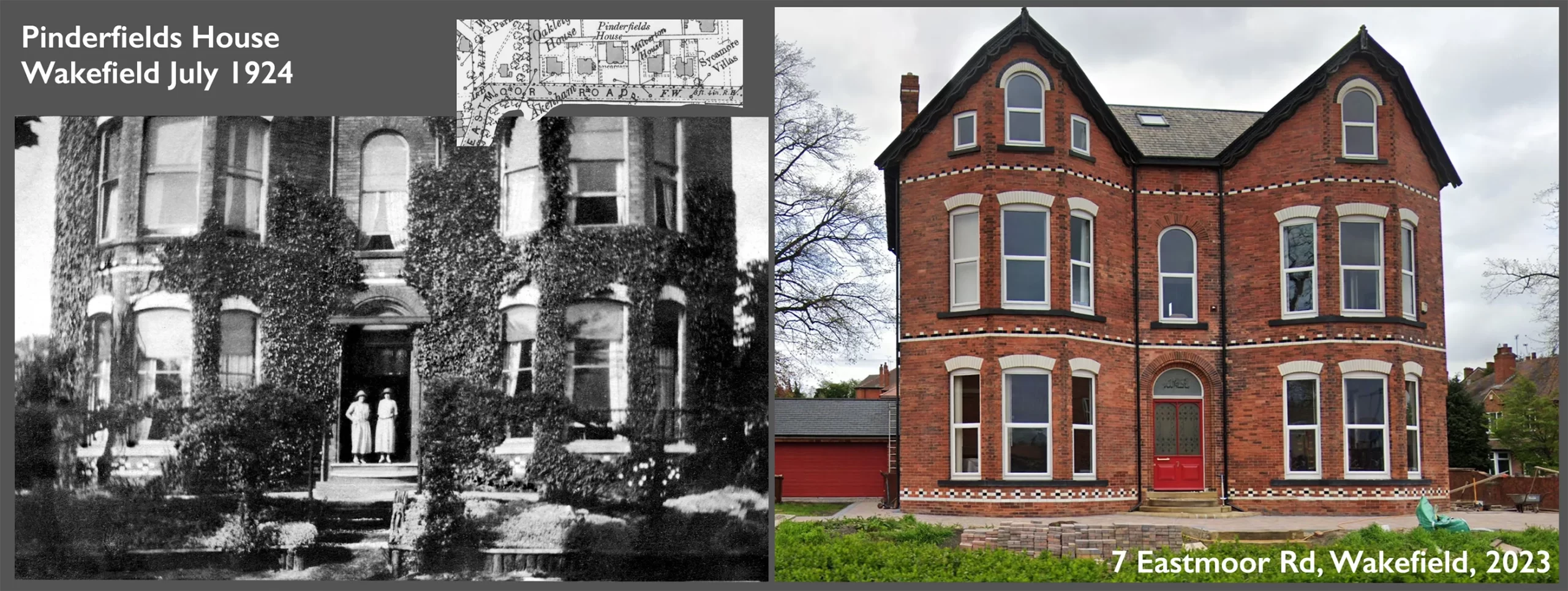
The grand, ivy-covered house in Wakefield looked huge in a picture of the two women standing in the doorway and I wondered if it was still standing. From a directory in 1927 I found Florence at 50 College Grove Rd and wrote to the Wakefield Historical Society to see if they were interested in a copy of the picture. Luckily my email was read by someone who knew that part of Wakefield well. I had mentioned the current building at that address didn’t look like the picture and she agreed. She thought it was 7 Eastmoor Road, just around the corner. She said it had recently been remodeled back to a house (having been made into multiple flats) and pointed out the decorative brickwork and windows were clearly visible in the 1924 picture when it was known as Pinderfields House.
The family tree says Florence’s two boys were 17 and 13 at the time of the visit, but no sign of them in pictures. After returning from Belfast in the summer of 1917 the family had moved at least once. Florence’s father, John Henry, was alive (until 1919) and they might have initially stayed with him. In the 1921 census they’re in Leeds and in Wakefield by 1924. By 1927 Florence is around the corner at 50 College Grove Road.
I don’t know the reasons for moving, but possibly it’s because she’s working as a housekeeper –in the 1939 register that’s her job, nearby at 3 College Grove Road (for a managing director of a shipping company). In 1927 through 1939 a Scottish doctor lived at 7 Eastmoor Road (employing a cook) and I wondered if Florence had been his housekeeper. A check of the medical registers showed he was in Scotland until some time in 1926, so mystery not solved.
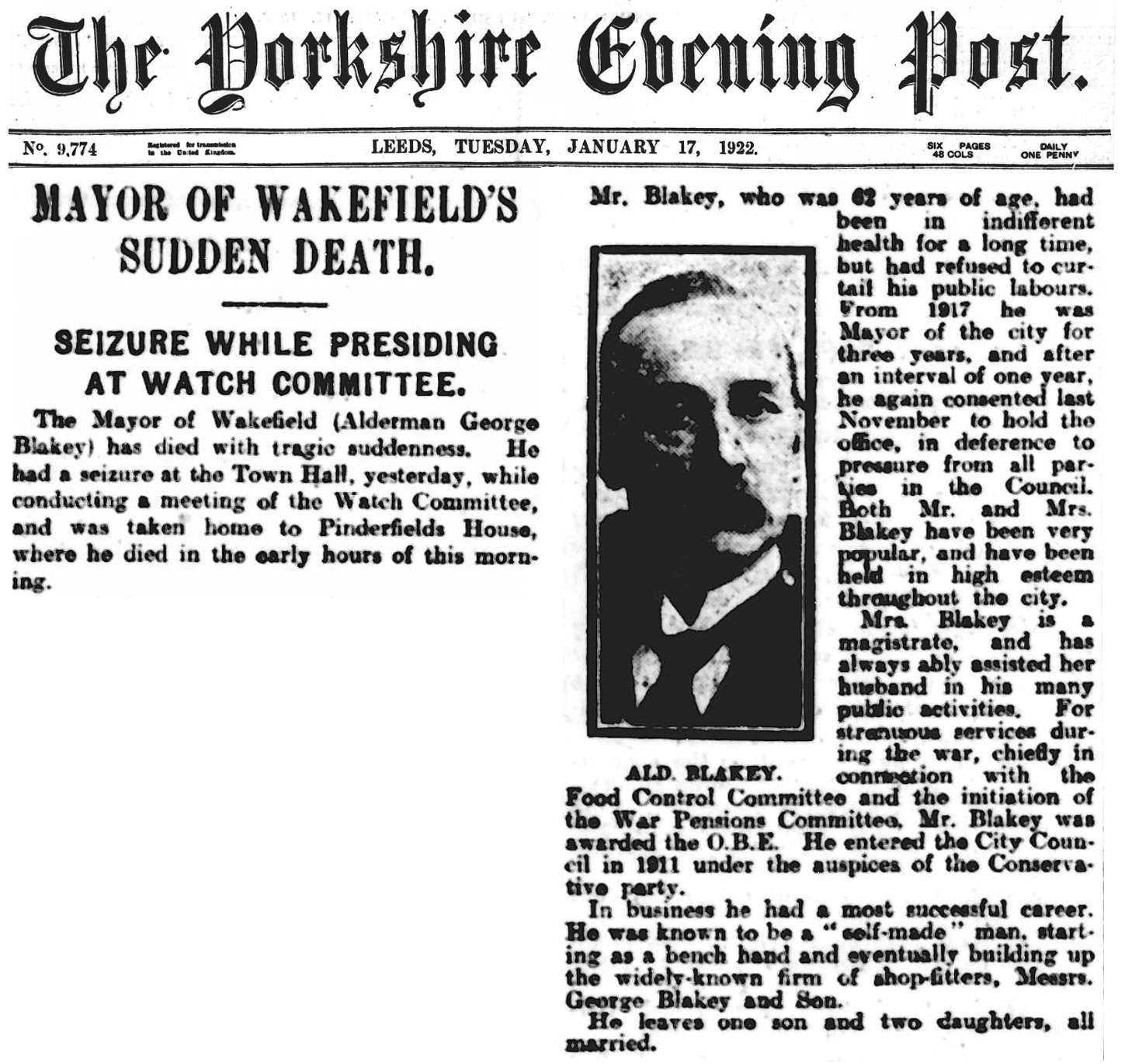
A few weeks after publishing this, email from the Wakefield Historical Society mentioned that Pinderfields House (as 7 Eastmoor Road was known) was the Mayor of Wakefield’s home until his sudden death in January 1922. Checking a local Wakefield city directory from 1922 it lists “Blakey Mrs” at Pinderfields House, suggesting she stayed on after his death – as a magistrate she probably had to continue her routine. Possibly Florence went to work as Ada Blakey’s housekeeper?
Good for Aunty Flo in managing to keep a roof over her head, but moving as employment changed can’t have been easy. Easy wasn’t much in evidence for any part of Florence Shepherd’s life.
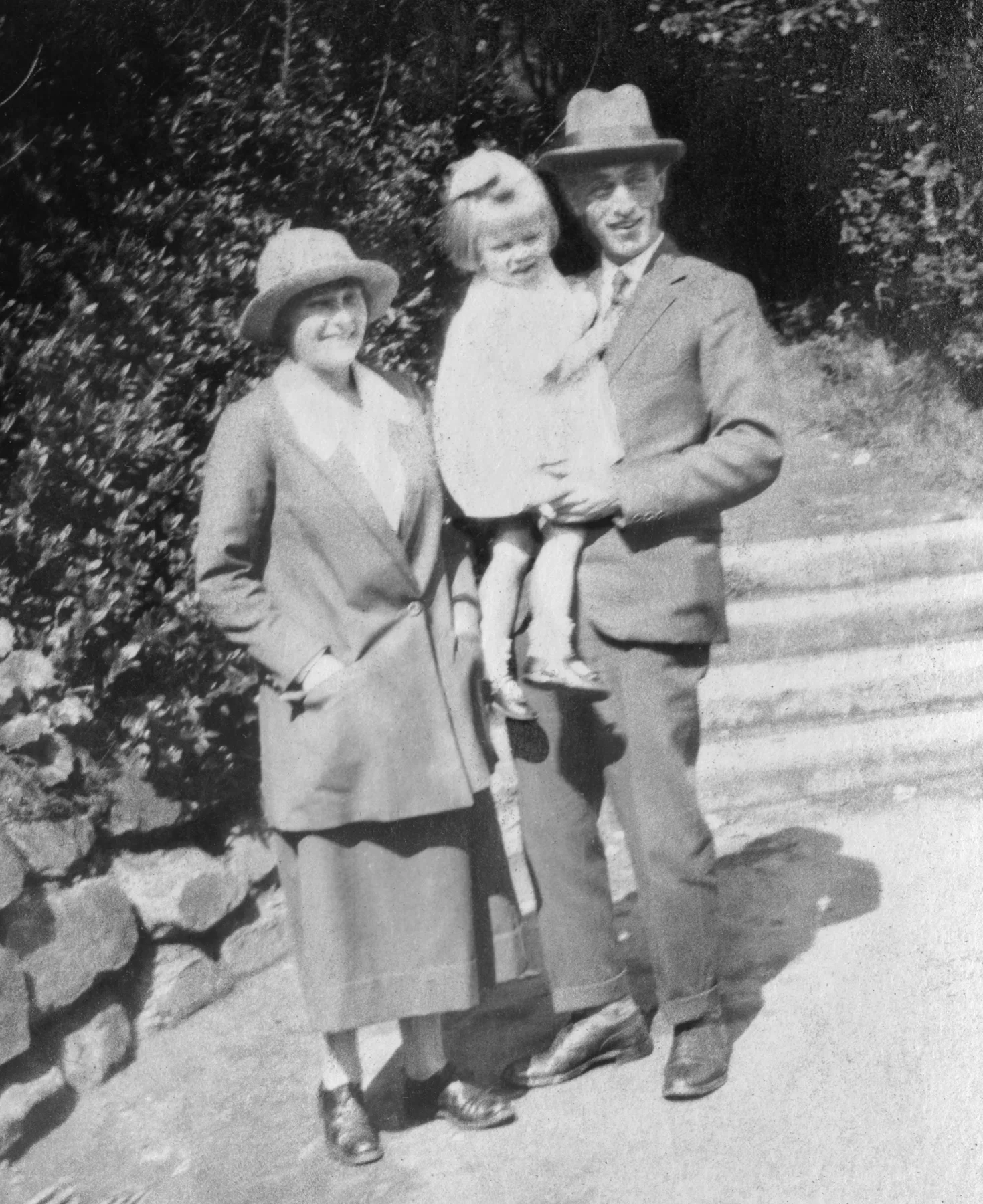
My grandparents (Gamps & Nanny) visited Yorkshire in July 1924, the year after they married. Two 27-year-olds (the girl is the daughter of a family friend) introducing Lilian to family in Yorkshire. Billie, Billee or Bill were Nanny’s nicknames –in the album Nanny wrote all three spellings. And it wasn’t new. Her younger brother Joe (Ernest Henry Williams) wrote “Billie, with love, Joe” on a photo of himself looking dashing in his Royal Field Artillery uniform . Later in life she was also Poppet (what my mother called her). The photo at left seems very dressed up for a visit to Scarborough beach, but the caption says this was “after a swim”!
Gamps’ Dad, the Wastrel, was not in Yorkshire at the time (on the run), but grandfather Edwin, sister Suzanne and aunt Florence Burdin (née Shepherd), were. Gamps’ other sisters were away – Emily Muriel teaching in Chelmsford, Gwen in Australia, Goggie in Portsmouth (but she and Nanny knew each other well) and Millicent Mary in London studying to be a nurse (it’s possible she was home for the summer but camera shy?). I wonder how much Gamps looked like his father – would local people who had known John Walden do a double take? I’d love to know the itinerary – did they go to Knottingley where Gamps was born? Did they visit the Poulson Brothers pottery in Ferrybridge? Did Gamps visit his uncles, Thomas and Charles (he could have talked with Thomas about cricket as they were both fans)? The album gives only two clues – Wakefield and Scarborough.
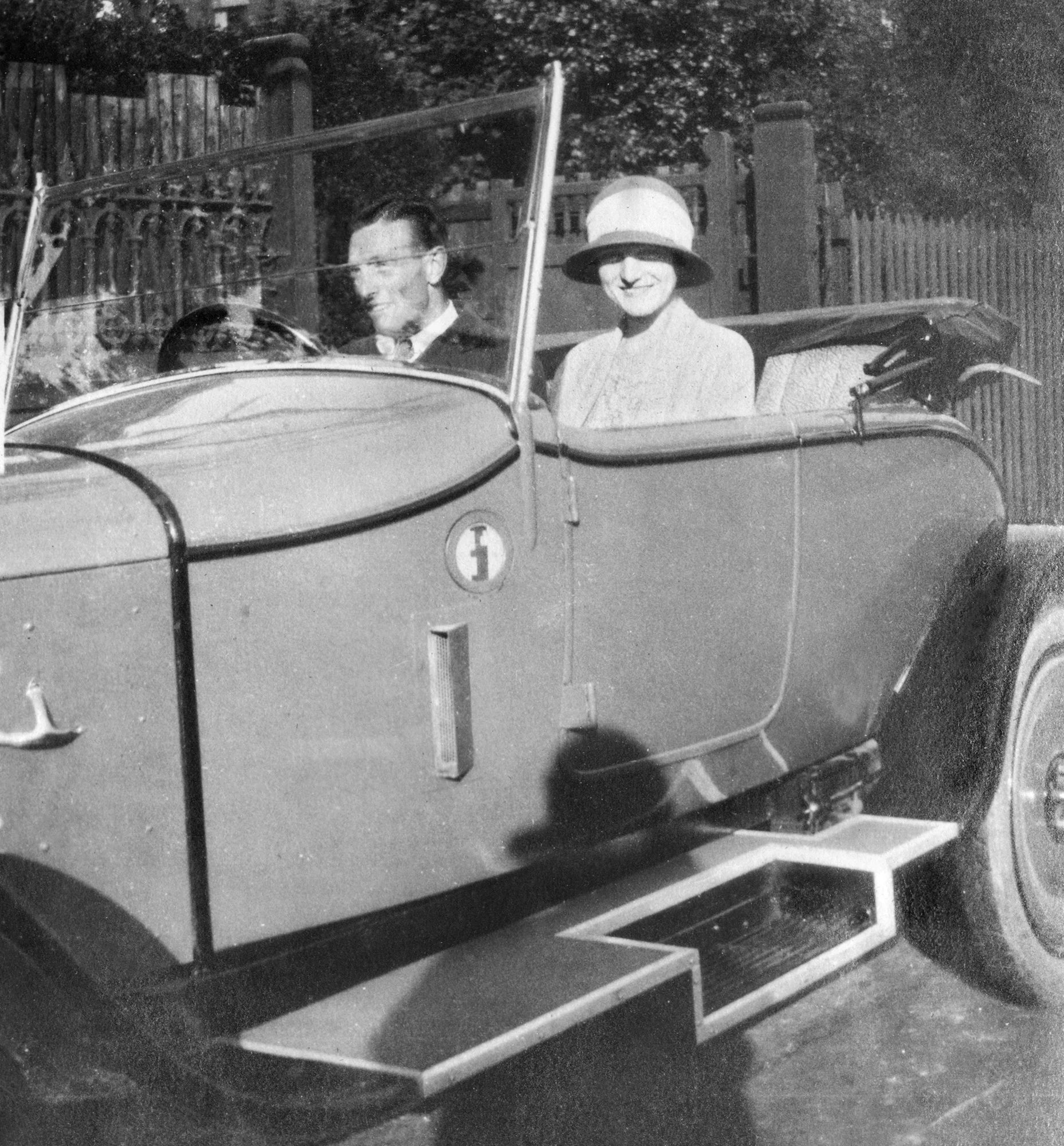
And then there’s the car! There are two pictures of it. From the looks of the surroundings I think they’re outside the house in Aunty Flo & Nanny’s picture. Florence is at the wheel in the cover image and my grandfather in this one with his youngest sister Ethel Suzanne (age 19) in the passenger seat. I didn’t recognize the car, but some online searches showed it was an AC Royal Roadster, described in an ad for a Leeds car dealer as “A British Car – and the least costly of its class to run per mile…The ideal car for ladies’ use. Top gear in Town or Country”. Prices depended on the model but were from £299 to £695. An article about a motor exhibition in 1927 noted that front-wheel brakes cost an extra £15! I don’t know if it was Florence’s car, but I love the notion of her pioneering as a woman behind the wheel. It’s more likely the car belonged to whoever Florence worked for and the Poulsons were just enjoying experiencing the novelty of being in a car. In 1920 there were only 187,000 cars in Britain although the number was quickly growing. Ada Blakey, if she was Flo’s employer, certainly had the money to afford a car. Her husband’s will left her just over £1 million in 2025 terms. The Wakefield Advertiser’s article about George Blakey’s death mentioned “motoring” as one of his interests.
As I collected details about Florence Shepherd’s early years, I was struck by how many family members had died much too young and wondered how that would shape your view of the world, especially with the Great War to add to the craziness. Here’s an overview of how things unfolded for Florence as a child and young woman.
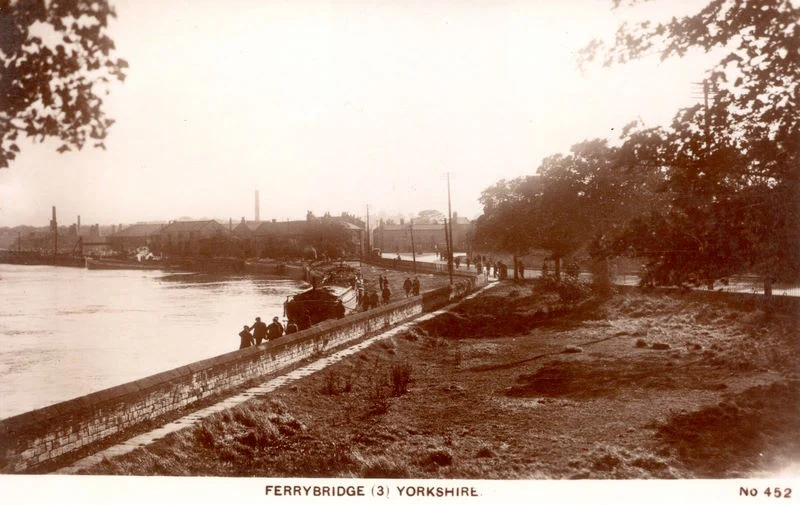
1881: Florence Shepherd was John Henry & Ann’s 6th child, born December 28th in Ferrybridge. Her older siblings ranged from 13 to 3. Age 4 she was very briefly (one month) an older sister, but sadly her premature baby brother, Charles died – “feebleness” was on the death certificate. Her young age and his short life probably lessened any sense of loss for her.
1889: Florence turned 7 in December 1888. In early January her mother Ann died from tuberculosis – phthisis pulmonalis; she was only 41. I’d guess that Ann wasn’t well for a while; she died at home, with her oldest daughter, Mary Ann, reporting to the registrar two days later. I can only imagine this was a horrible loss for the family, even though dying young was much more common in the late 19th and early 20th centuries than it is now and tuberculosis was widespread. Older siblings likely kept Flo’s routine going so the family still largely functioned. A few months later, in April, Flo’s oldest brother Samuel left for a stable hand/coachman job in Bulstrode, over 180 miles south of Ferrybridge.
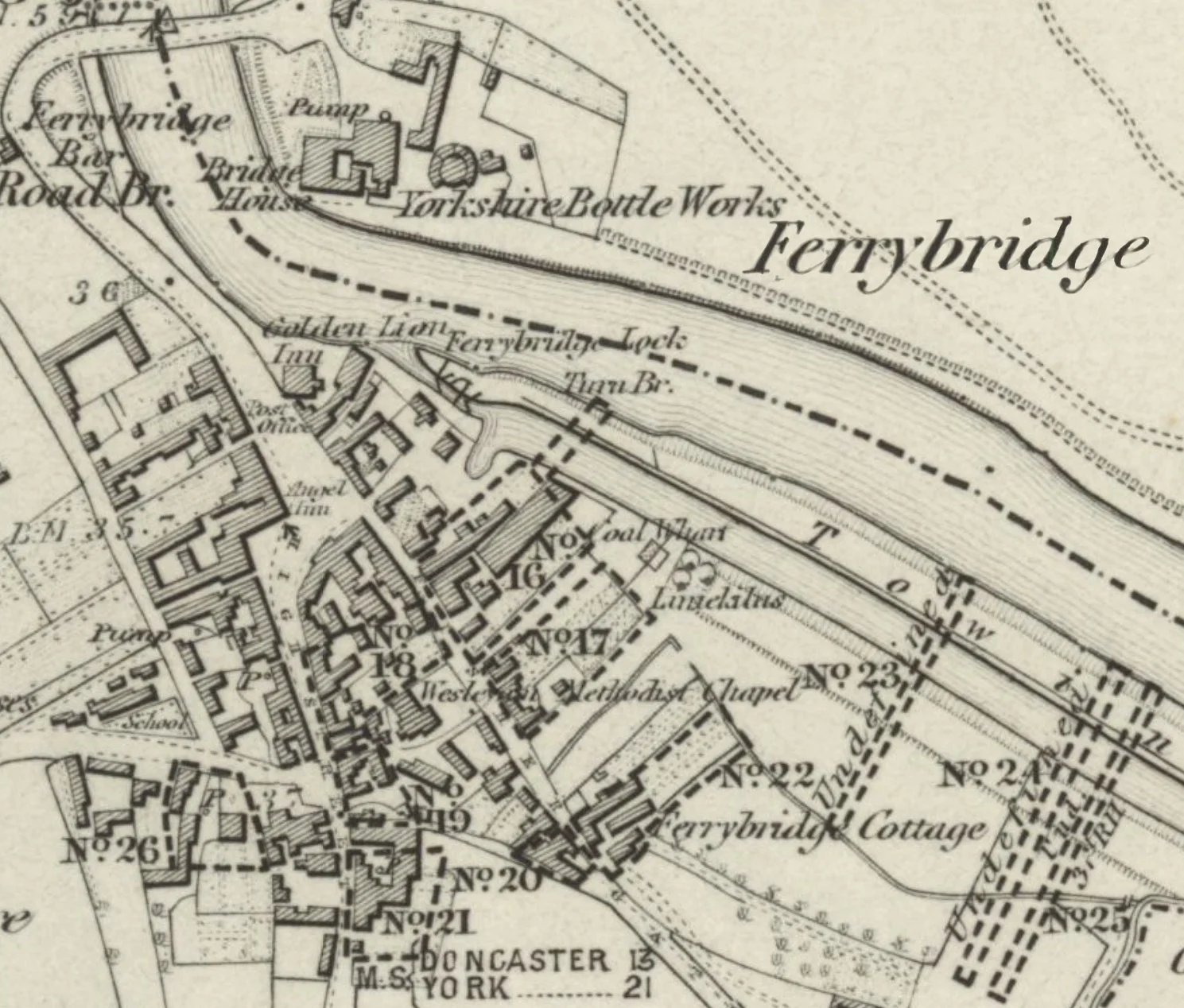
The year brought one change after another. The next was Florence’s father, John Henry, remarrying in June. Susannah was a widow with no children, but lots of experience running inns & pubs. She and John Henry ran the Red Lion Inn (later renamed The Golden Lion) while the older children – Mary Ann and Emma Jane were 19 & 17 – took care of the household and boarders. Based on old ordnance survey maps, it appears Argyle House was a short walk away from the Red Lion.
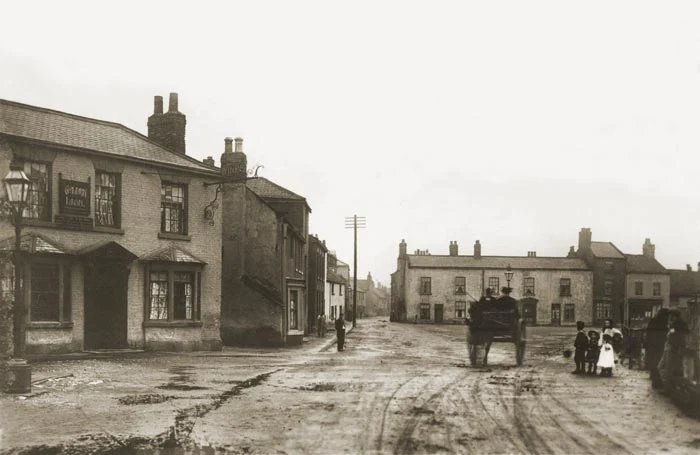
In the late Autumn it must have become obvious Mary Ann was pregnant and John Henry ensured (I wish I had details!) his oldest daughter was married to the baby’s father. The wedding was on Christmas Day 1889 in St Andrew’s Ferrybridge, one last event in a most eventful year and I assume the Shepherd children (except for Sam) were all there.
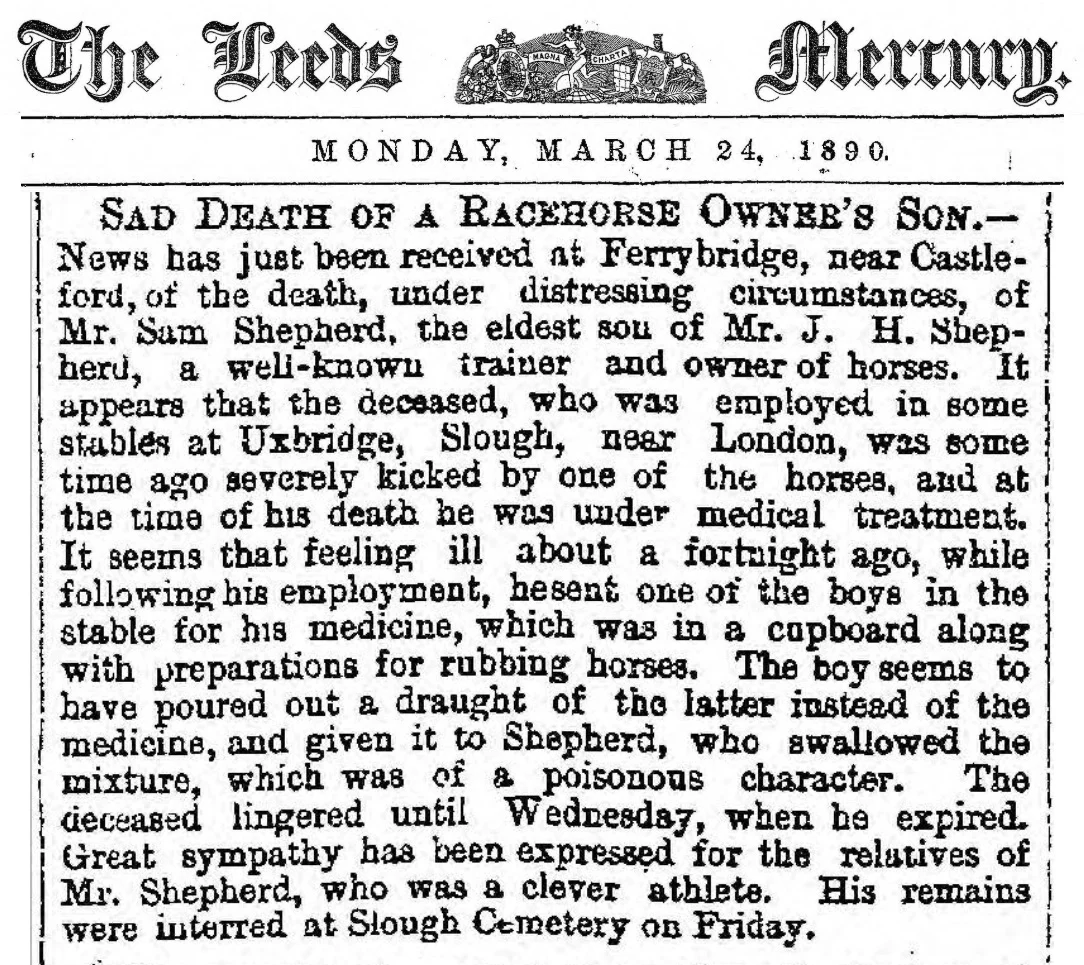
1890: The following Spring, the family suffered a tragic loss. In mid-March Sam Shepherd died –the local papers carried a short version of the story which was very sad, but as it turns out, not a truthful version of events. I can’t know, but have to assume the family didn’t want neighbors to judge harshly. A newspaper account of the inquest into Sam’s death – at which John Henry testified – is unbelievably sad. The article doesn’t say which of Sam’s many cousins was with his father at the funeral (and possibly this was for John Henry to have family support versus being on his own?).

On a happier note, John Henry’s first grandchild, Emily Muriel Poulson was born in May 1890 (to John Walden & Mary Ann) and Florence became Aunty Flo – at age 8!
Flo’s grandfather, Samuel Shepherd the retired coal merchant, lived nearby, on Pontefract Road, next door to a widowed daughter-in-law and a grandson. Sam was retired and a widower with another grand-daughter (Eliza) living with him, so possibly Flo got to know him. In October 1892, age 90, Sam died.
1899: Florence’s life – I assume as a student until at least age 12 (then the school-leaving age!) – continued quietly, possibly helping at the Golden Lion Inn or other family tasks. Although her oldest sister (Mary Ann) now had four children, she was in Knottingley, about 35 minutes walking distance; no records to say if she was helping out with her nieces and nephew. In May Mary Ann gave birth, but died shortly afterward. Her funeral was a standing room only event at the Wesleyan burial ground according to the local paper, and I think Florence is who they referred to as Miss Florrie Shepherd (she and her brother Alfred were in the third coach, apparently arranging them in age order; they shared that coach with Edwin Llewellyn Poulson & his wife. There were nine coaches total).
In August, Florrie’s Uncle George died of tuberculosis (age 63); a sad event, but looking at his family (he had 6 daughters) made it clear that the Shepherds and the Burdins were well acquainted – via the Sweeting family. One of Florence’s many cousins was Annie Shepherd, Uncle George’s oldest; Annie was 22 years older than Florence – Annie’s oldest daughter Gertrude was Florence’s age. Annie’s husband Fred Sweeting was the brother of Harriet Sweeting who married Isaac Burdin Sr (are you still with me?) Isaac & Harriet’s second son, Isaac Jr somehow met and got to know Florence. Fast forward a few years and…
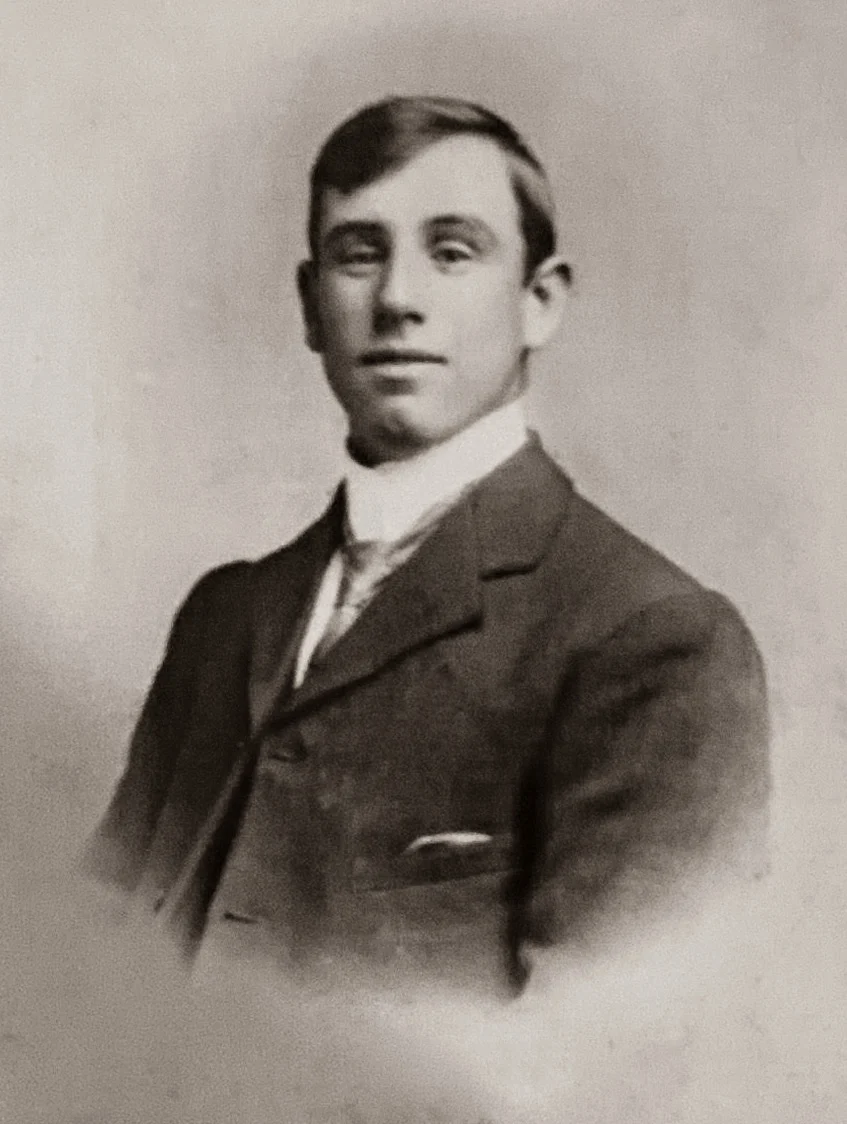
1905: On June 25th, Florence married Isaac Burdin, Jr (his family ran a glass bottle factory in Knottingley; Isaac Sr and John Henry Shepherd were involved with local politics, so the families were surely acquainted). Florence & Issac had a son in December 1906. For some reason (no clues) in April 1907 Isaac departed for Cardiff to join the cargo vessel Semantha as purser on a voyage to Varna, Bulgaria, returning in July. The ship’s log records that Isaac left the Semantha in Antwerp on Jun 21st, that it was his first voyage and he was “directed” to leave in Antwerp (discharge is the notation when crew leave at the end). There was no record of money paid as there was for other crew. No idea how he made it home from Antwerp either. His address in the log is Beverly House, Ferrybridge, John Henry Shepherd’s house, so perhaps that’s where Florence and the baby stayed? Not sure what I’m missing, but it seems the time to explore the world as ship’s crew is before you start a family.
Isaac appears to have returned to the family business – in the 1911 census he is an “employer” at a glass manufacturer. His older brother Herbert’s entry is the same and their father, Isaac Sr, is “Retired Glass Bottle Manufacturer”. In the Autumn, Florence and Isaac’s second son was born.
It isn’t clear when Isaac went to work for a Belfast glass bottle manufacturer (David Wright & Co), but from the address for Florence on her sister Emma Jane’s death certificate, Isaac and family were in Belfast by July 1914. Picking up and moving with young children to a location where you have no family help and support is hard, but I assume the opportunity to manage a plant independently from his older brother might have been appealing?
Florence’s oldest surviving sister Emma Jane died of tuberculosis on July 1, 1914 and Florence was with her sister at their father’s house in Ferrybridge. Emma Jane had been there for a couple of months (according to the story in the Pontefract and Castleford Express). In addition to the indication of closeness that Florence traveled from Belfast, Florence was a witness at her sister’s 1900 marriage to a farmer, Bennet Simpson, and their first child was called Florence Margaret. The three children, 12, 9 and 6, had lost their mother but Florence had to return to her children in Belfast and it doesn’t appear there are any Simpson family members nearby. Perhaps Bennet farms and Florence Margaret is the housekeeper/cook/caregiver for the younger two?
1917 was a truly horrible year for Florence Burdin. On April 5th, her stepmother Susannah died. From the funeral account in the newspaper it appears that the surviving Shepherd children were all there – Emily (Mrs Poulson) Sgt Jack Shepherd (I assume John Henry Shepherd jr), Sgt A Shepherd (Alfred), and Florence (Mrs Burdin). There was a very long (and very confusing) list of nieces, nephews & ln-laws. Mrs EL Poulson, Knottingley would have been Edwin Llewellyn’s third wife, his former housekeeper. Wreaths came from many people including: “Family and Children”, Millicent and Ethel. That has to be John Walden & Emily’s two girls.
No records, but I assume Florence made it back to Belfast some time later in April. Isaac had dealt with asthma for 12 years, and on May 30th he succumbed to an attack at home, lost consciousness and died. Isaac’s very brief will was written in February, suggesting his health had taken a turn for the worse . It’s likely that his older brother Herbert made it to Belfast to see him – a letter Herbert wrote the day after Isaac’s death to a business associate apologized for the delay in replying because of his brother’s ill health and death. Isaac’s body was very quickly returned to Knottingley (Fleetwood Steamer, Railway & freight expenses listed; with no refrigeration a distant funeral was complicated). Isaac was buried June 1st (three days after his death); J.W Hemmant in Pontefract handled the arrangements. The death certificate mentions the name of someone at 38 Eblana St “causing the body to be buried” as the one who reported Isaac’s death. I don’t know how you arrange for people to attend a funeral in two days – but Hemmant charged for obituary notices and hearse carriages – so perhaps there was a memorial service later?
Isaac’s will left a modest amount of money – he didn’t own a house; primarily it was some cash in the Bank of Ireland – to Florence. She and William Edwin Spinks McGowan (a Pontefract printer married to Harriet Burdin, Isaac’s sister) were executors. We’ll return to McGowan shortly.
Two weeks later, on June 13th, Florence’s older sister Emily died, also of tuberculosis (the death certificate said (1) lupus of larynx, (2) exhaustion) and her will named Florence and William Edwin Spinks McGowan executors and guardians of “my infant children”. Millicent Mary and Ethel Suzanne were 14 and 12, and Millicent was the one with her mother when she died; so minors, but not infants. The will was dated June 5, 1917, but perhaps was an update from an earlier version when the girls were infants? And was 1917 McGowan-as-executor year? Or was Harriet a good friend of Emily? Why wouldn’t Florence as widow be enough of a guardian for her minor children? It seems strange to 2025 eyes.
Emily’s will made no mention of John Walden, and none of the four older children she was stepmother to (who were all by now adults, and in the case of the youngest, my grandfather, in the Army fighting in The Great War). It’s possible that Emily didn’t know John Walden had returned from Canada in 1916. It’s possible she didn’t care where he was as she figured he was no use to the two girls.
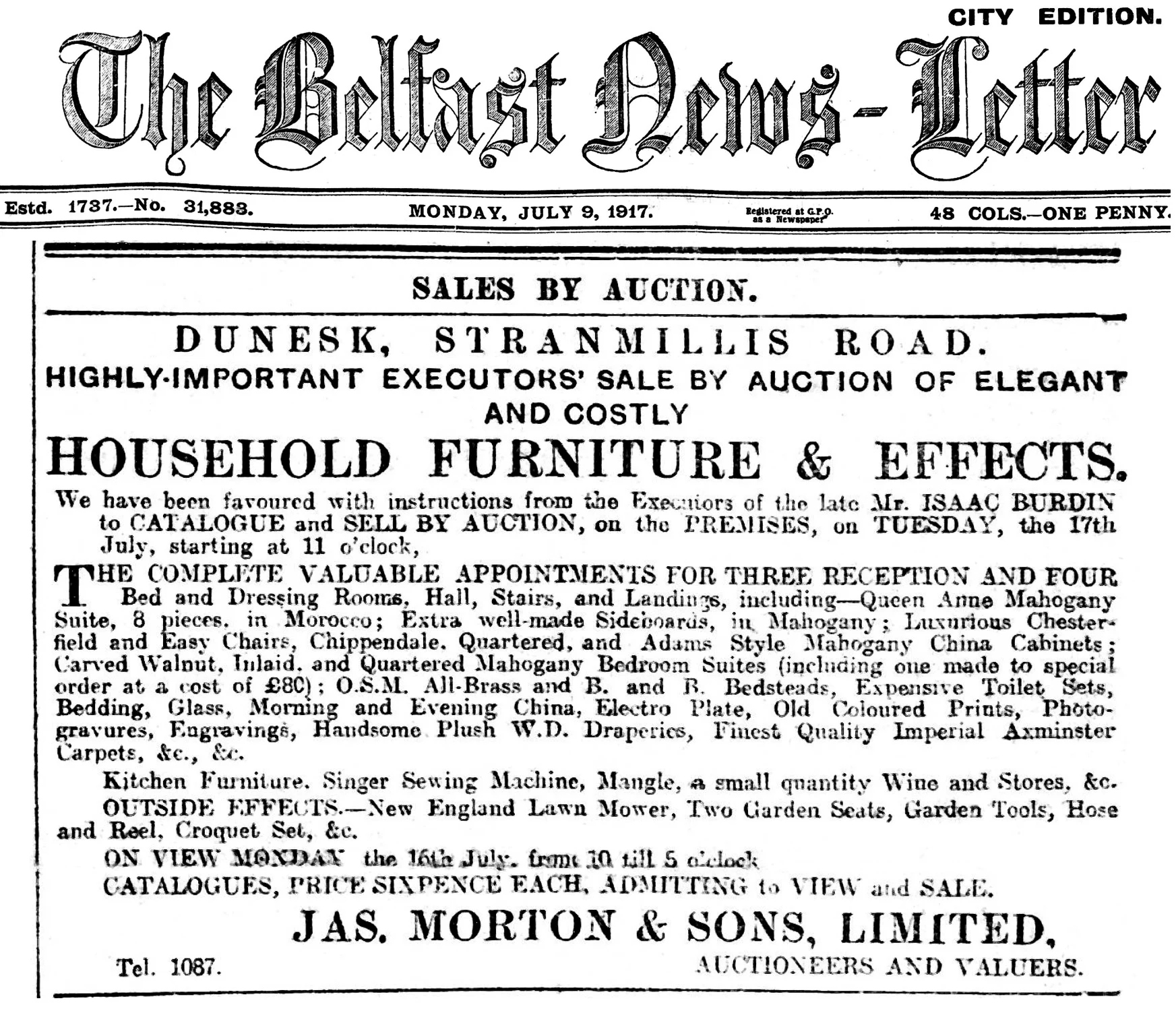
Auctioning off all the Belfast household furniture and effects in July at first seemed odd – why wouldn’t they just be moved to a new house? Thinking about it, I can only assume money was now an issue and paying to move items too large for whatever house they could now afford made no sense. The “Bedroom Suite made to order at a cost of £80” translates to about £7,000 in 2025 terms! Perhaps it’s just an auctioneer encouraging interest, but it seems to indicate from now on things would have to be simpler (and cheaper!).
To top off a terrible year, in August, Florence’s niece (Emma Jane’s oldest) Florence Margaret Simpson died of tuberculosis at 15. Her father Bennet was “in attendance”.
1919: Florence’s father, John Henry Shepherd, died (age 75). In addition to Florence and her two surviving brothers (JH and Alfred), “Misses Poulson” came to the funeral. Probably that means Millicent Mary and Ethel Suzanne – my grandfather was still in India, Emily Muriel was teaching in Chelmsford, Gwen had moved to Australia in 1918 and Goggie (Doris) was working as a heath visitor in Portsmouth. Edwin Llewellyn Poulson attended as did Bennet Simpson. “A concourse of people at the graveside” as the newspaper said.
Florence’s brother John Henry died of pneumonia in March 1929. Her remaining brother, Alfred, died of tuberculosis on New Year’s Day in 1934. Florence was now the only surviving child – at only 52. That seems crazy and cruel and hard. But Florence in the 1924 pictures seems to be smiling nevertheless – great actor or just a resilient spirit.
As a happier coda: in 1934 there were two family milestones – both Florence’s son’s were married. Kenneth on June 6th with his brother as a groomsman and cousin Ethel Suzanne as a bridesmaid. John Henry was married July 7th – no details as the newspapers didn’t cover it as they had when Kenneth’s bride was the daughter of a former Mayor of Wakefield. In the late fall of 1934, John Henry and Zoë gave birth to Florence’s first grandson (and continued the pattern I’ve seen so often of babies arriving less than 9 months after their parents’ marriage!)

